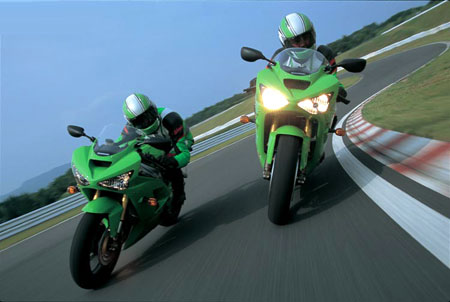
Back to 2003 Kawasaki Motorcycle Index Page
Click photo to enlarge.
It makes a great desktop image.
– 2003 Kawasaki Ninja ZX-6R
.
Stronger. Quicker. Lighter.
Every sportbike rider wants a clear “advantage” — a technological edge the competition can’t touch. Well, the all-new Ninja® ZX-6R has it. More displacement equals more muscle, so we gave the ZX-6R’s compact new DOHC In-Line Four a displacement bump to 636cc. Next, we added wild 12.8:1 lightweight pistons, electronic fuel injection, a stratospheric redline for peak power, and a close-ratio gearbox to maximize performance. And the ZX-6R reflects Kawasaki’s passion for turning low mass into precise handling. We started with a new pressed-aluminum perimeter frame and extruded aluminum swingarm, then added a class-leading inverted 41mm front fork and Bottom-Link UNI-TRAK® rear suspension with piggy-back shock. Super-wide 17-inch rims, Z-rated radial rubber, and Moto-GP inspired bodywork complete this rather tantalizing picture. So let ’em cry foul. You and your advantage will be long gone by then.
“All-out sportbike performance and aggressive styling” is the best way to sum up the all-new 2003 Kawasaki NINJA® ZX-6R sportbike. Based on the limited edition NINJA® ZX-6RR, the radical new ZX-6R boasts a redesigned engine and crankcase with 37 extra cubic centimeters of displacement, an electronic fuel injection system and an all-new chassis. These new features, plus a host of additional design changes, are sure to leave the competition hung out to dry.
Features:
– All-new engine displaces 636cc due to a 2mm larger bore. Composite chrome-plated cylinders with 5mm shorter skirts reduce weight. The result is more mid-range punch than the competition.
– New cooling passages, new front cylinder head frame mount and oil routing moved to inside the engine help improve efficiency and reduce weight.
– New camshaft profiles with smaller slotted sprockets, 10mm shorter valve stems and single intake valve springs help reduce engine height and weight, and improve power.
– Bottom-Link UNI-TRAK® rear suspension features remote piggy-back style reservoir, stepless compression and rebound damping adjustment, threaded rear ride height adjustment and a special top-out spring for more precise control under heavy braking.
– Lighter, more compact radiator with new ring-style cooling fan.
– All-new Ram Air intake system routes the incoming air through a central intake. Design of the front cowling directs air into the intake for improved efficiency.
– Transmission features closer ratios for third through sixth gears. Revised shift drum cam profile for improved shifting.
– Digital instrumentation in the cockpit includes a compact central instrument for the following functions: radial tachometer, speedometer, temperature, odometer, tripmeter, clock and stopwatch. Shift indicator lamp adjustable for engine rpm and brightness.
– All-new aluminum perimeter frame is lighter, more compact. Rake is 25 degrees. Moving the swingarm pivot forward helps shift weight bias onto the front wheel.
– New front 41mm inverted Kayaba cartridge fork features stepless adjustment for compression and rebound damping. New top-out springs offer improved fork action under hard acceleration.
– Bottom-Link UNI-TRAK® rear suspension features remote piggy-back style reservoir, stepless compression and rebound damping adjustment, threaded rear ride height adjustment and a special top-out spring for more precise control under heavy braking.
– New tail section with lightweight LED taillights and aerodynamic inner rear fender.
Rear disc brake measures 220mm and improved master cylinder ratios improve both feel and performance.
– First for a production bike, radially mounted 4-piston front disc brakes position the lighter yet larger calliper further away from the axle for improved braking efficiency.
– Individual brake pads for each piston distribute heat more evenly and offer more bite under hard braking.
– All-new Moto-GP styling and aerodynamic fairing are products of the research in building the new GP four-stroke race machine.
Specifications:
Ninja ZX-6R
Engine type 4-stroke, liquid-cooled In-Line Four
Displacement 636cc
Bore x stroke 68 x 43.8mm
Compression Ratio 12.8:1
Valve system DOHC, 16 valves
Fuel system Digital fuel injection with four 38mm throttle bodies
Ignition Digital
Starting Electric
Transmission 6-speed with Positive Neutral Finder
Frame type Perimeter, pressed aluminum
Rake/trail 24.5°/95 mm (3.7 inches)
Suspension, front 41mm inverted cartridge fork with adjustable preload, stepless compression and rebound damping
Suspension, rear Bottom-Link UNI-TRAK® with remote-reservoir, gas-charged shock, adjustable ride height, spring preload, stepless compression and rebound damping
Tires, front, rear Tubeless radial; 120/65-ZR17; 180/55-ZR17
Brakes, front Dual 280mm radial-mounted discs with dual 4-piston calipers
Brakes, rear Disc with single-piston caliper
Wheelbase 1400 mm (55.1 inches)
Seat height 825 mm (32.5 inches)
Fuel capacity 18 litres (4 gallons)
Dry weight 161 kg (355 pounds)
Colours Black Pearl or Lime Green or Passion Red or Galaxy Silver
GTPP available 24 or 36 months
Specifications are subject to change without notice, in accordance with national regulation and legislations.








Be the first to comment